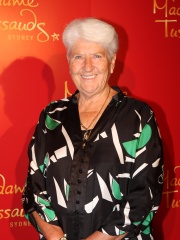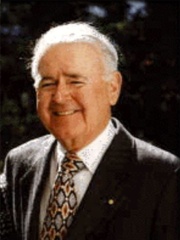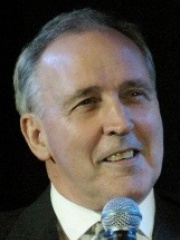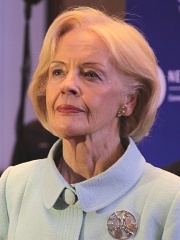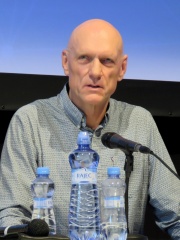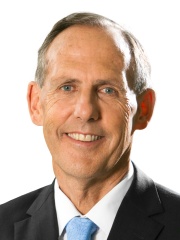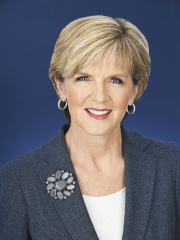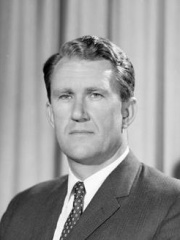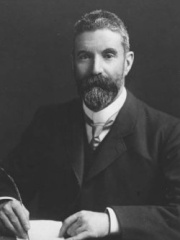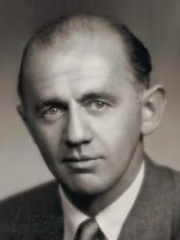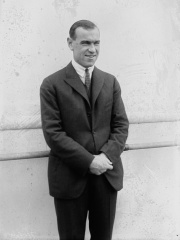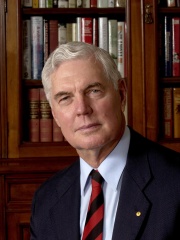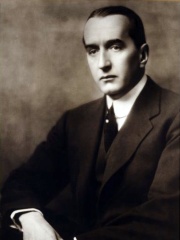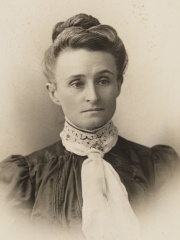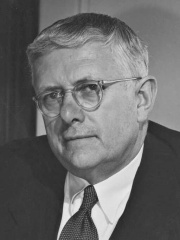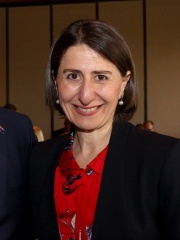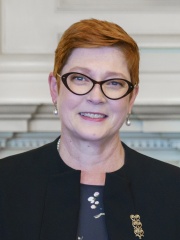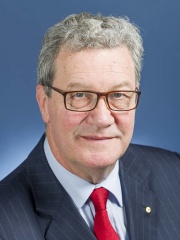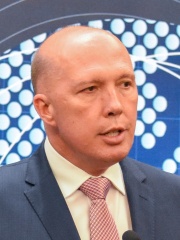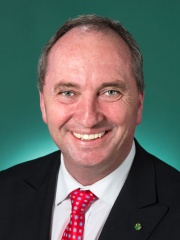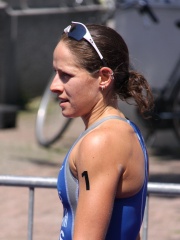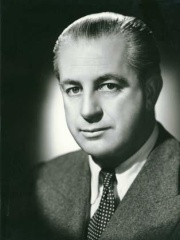
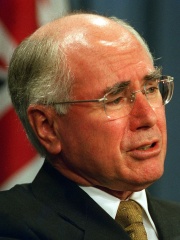
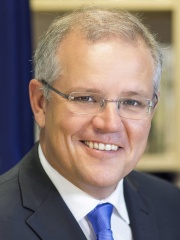
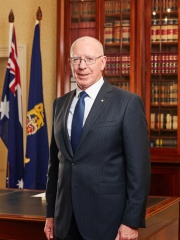
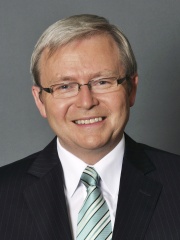
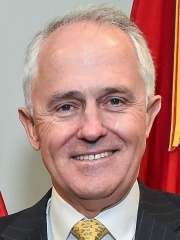

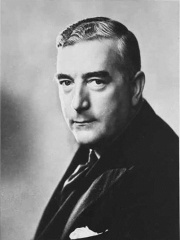
The Most Famous
POLITICIANS from Australia
This page contains a list of the greatest Australian Politicians. The pantheon dataset contains 15,577 Politicians, 50 of which were born in Australia. This makes Australia the birth place of the 60th most number of Politicians behind Tunisia and Uruguay.
Top 10
The following people are considered by Pantheon to be the top 10 most legendary Australian Politicians of all time. This list of famous Australian Politicians is sorted by HPI (Historical Popularity Index), a metric that aggregates information on a biography’s online popularity. Visit the rankings page to view the entire list of Australian Politicians.

1. Harold Holt (1908 - 1967)
With an HPI of 55.46, Harold Holt is the most famous Australian Politician. His biography has been translated into 41 different languages on wikipedia.
Harold Edward Holt (5 August 1908 – 17 December 1967) was an Australian politician and lawyer who served as the 17th prime minister of Australia from 1966 until his disappearance and presumed death in 1967. He held office as leader of the Liberal Party of Australia. Holt was born in Sydney and moved to Melbourne in childhood, studying law at the University of Melbourne. Before entering politics he practised law and was a lobbyist for cinema operators. He was first elected to the House of Representatives at the age of 27, becoming a member of parliament (MP) for the division of Fawkner at a by-election in 1935. A member of the United Australia Party (UAP), Holt was made a minister without portfolio in 1939, when his mentor Robert Menzies became prime minister. His tenure in the ministry was interrupted by a brief stint in the Australian Army, which ended when he was recalled to cabinet following the deaths of three ministers in the 1940 Canberra air disaster. The government was defeated in 1941, sending the UAP into opposition, and he joined the new Liberal Party upon its creation in 1945. When the Liberals came to office in 1949, Holt became a senior figure in the new government. As Minister for Immigration (1949–1956), he expanded the post-war immigration scheme and relaxed the White Australia policy for the first time. He was also influential as Minister for Labour and National Service (1949–1958), where he handled several industrial relations disputes. Holt was elected deputy leader of the Liberal Party in 1956, and after the 1958 election replaced Arthur Fadden as Treasurer. He oversaw the creation of the Reserve Bank of Australia and the decimal Australian dollar, but was blamed for a credit crunch that almost cost the Coalition the 1961 election. However, the economy soon rebounded and Holt retained his place as Menzies' heir apparent. Holt became prime minister in January 1966, elected unopposed as Liberal leader following Menzies' retirement. He fought a general election later that year, winning a landslide victory. The Holt government continued the dismantling of the White Australia policy, amended the constitution to give the federal government responsibility for indigenous affairs, and took Australia out of the sterling area. Holt promoted greater engagement with Asia and the Pacific, and made visits to a number of East Asian countries. His government expanded Australia's involvement in the Vietnam War, and maintained close ties with the United States under President Lyndon B. Johnson. While visiting the White House, Holt proclaimed that he was "all the way with LBJ", a remark which was poorly received at home. In December 1967, Holt disappeared while swimming in rough conditions at Cheviot Beach, Victoria. He was presumed dead, although his body was never recovered; his disappearance spawned a number of conspiracy theories. Holt was the third Australian prime minister to die in office. He was succeeded by Country Party leader John McEwen on an interim basis and then by John Gorton. His death was commemorated in a number of ways, among them by the establishment of the Harold Holt Memorial Swimming Centre in Melbourne.

2. John Howard (1939 - )
With an HPI of 53.16, John Howard is the 2nd most famous Australian Politician. His biography has been translated into 69 different languages.
John Winston Howard (born 26 July 1939) is an Australian former politician who served as the 25th prime minister of Australia from 1996 to 2007. He held office as leader of the Liberal Party of Australia, having previously served as the treasurer of Australia from 1977 to 1983 under Prime Minister Malcolm Fraser. His eleven-year tenure as prime minister is the second-longest in Australian history, behind only Sir Robert Menzies. Howard has also been the oldest living Australian former prime minister since the death of Bob Hawke in May 2019. Howard was born in Sydney and studied law at the University of Sydney. He was a commercial lawyer before entering parliament. A former federal president of the Young Liberals, he first stood for office at the 1968 New South Wales state election, but lost narrowly. At the 1974 federal election, Howard was elected as a member of parliament (MP) for the division of Bennelong. He was promoted to cabinet in 1977, and later in the year replaced Phillip Lynch as treasurer of Australia, remaining in that position until the defeat of Malcolm Fraser's government at the 1983 election. In 1985, Howard was elected leader of the Liberal Party for the first time, thus replacing Andrew Peacock as Leader of the Opposition. He led the Liberal–National coalition to the 1987 federal election, but lost to Bob Hawke's Labor government, and was removed from the leadership in 1989. Remaining a key figure in the party, Howard was re-elected leader in 1995, replacing Alexander Downer, and subsequently led the Coalition to a landslide victory at the 1996 federal election. In his first term, Howard introduced reformed gun laws in response to the Port Arthur massacre, and controversially implemented a nationwide value-added tax, breaking a pre-election promise. The Howard government called a snap election for October 1998, which they won, albeit with a greatly reduced majority. Going into the 2001 election, the Coalition trailed behind Labor in opinion polling. However, in a campaign dominated by national security, Howard introduced changes to Australia's immigration system to deter asylum seekers from entering the country, and pledged military assistance to the United States following the September 11 attacks. Due to this, Howard won widespread support, and his government would be narrowly re-elected. In Howard's third term in office, Australia contributed troops to the War in Afghanistan and the Iraq War, and led the International Force for East Timor. The Coalition would be re-elected once more at the 2004 federal election. In his final term in office, his government introduced industrial relations reforms known as WorkChoices, which proved controversial and unpopular with the public. The Howard government was defeated at the 2007 federal election, with the Labor Party's Kevin Rudd succeeding him as prime minister. Howard also lost his own seat of Bennelong at the election to Maxine McKew, becoming only the second prime minister to do so, after Stanley Bruce at the 1929 election. Following this loss, Howard retired from politics, but has remained active in political discourse. Howard's government presided over a sustained period of economic growth and a large "mining boom", and significantly reduced government debt by the time he left office. He was known for his broad appeal to voters across the political spectrum, and commanded a diverse base of supporters, colloquially referred to as his "battlers". Retrospectively, ratings of Howard's premiership have been polarised. His critics have admonished him for involving Australia in the Iraq War, his policies regarding asylum seekers, and his economic agenda. Nonetheless, he has been frequently ranked within the upper-tier of Australian prime ministers by political experts and the general public.

3. Scott Morrison (1968 - )
With an HPI of 52.00, Scott Morrison is the 3rd most famous Australian Politician. His biography has been translated into 74 different languages.
Scott John Morrison (born 13 May 1968) is an Australian former politician who served as the 30th prime minister of Australia from 2018 to 2022, holding office as leader of the Liberal Party of Australia. He was the member of parliament (MP) for the New South Wales seat of Cook from 2007 until 2024. On 23 January 2024, he announced his departure from politics, and resigned on 28 February 2024. Morrison was born in Sydney and studied economic geography at the University of New South Wales. He worked as director of the New Zealand Office of Tourism and Sport from 1998 to 2000 and was managing director of Tourism Australia from 2004 to 2006. Morrison also was state director of the New South Wales Liberal Party from 2000 to 2004. He was first elected to the Australian House of Representatives at the 2007 election as a member of parliament (MP) for the division of Cook in New South Wales, and was quickly appointed to the shadow cabinet. After the Liberal-National coalition's victory at the 2013 election, Morrison was appointed Minister for Immigration and Border Protection in the Abbott government, where he was responsible for implementing Operation Sovereign Borders. In a reshuffle the following year, he became Minister for Social Services. He was later promoted to the role of Treasurer in September 2015, after Malcolm Turnbull replaced Abbott as prime minister. In August 2018, Home Affairs Minister Peter Dutton unsuccessfully challenged Turnbull for the leadership of the Liberal Party. Leadership tensions continued, and the party voted to hold a second leadership ballot days later, with Turnbull choosing not to stand. In that ballot, Morrison was seen as a compromise candidate and defeated both Dutton and Foreign Minister Julie Bishop to become party leader and thus prime minister in August 2018. Morrison won a second term after leading the Coalition to an upset victory in the 2019 election. Morrison drew near unanimous condemnation for taking a holiday during Australia's 2019–20 bushfire season and for his government's response to the disaster. Morrison also faced criticism for his response to the 2021 Parliament sexual misconduct allegations. During the COVID-19 pandemic, Morrison established the National Cabinet, and Australia received praise during 2020 for being one of the few Western countries to successfully suppress the virus, though the slow initial pace of the COVID-19 vaccination rollout was criticised. In foreign policy, Morrison oversaw the signing of the AUKUS security pact and increased tensions between Australia and China and Australia and France. Morrison directed logistical support to Ukraine as part of the international effort against Russia in the wake of the 2022 Russian invasion of Ukraine. Morrison has also been criticised for his government's response to the 2022 eastern Australia floods, and his perceived inaction on climate change. The government was defeated at the 2022 election and Morrison stepped down as leader of the Liberal Party; Peter Dutton was elected unopposed to replace him. After leaving office, Morrison became involved in a scandal after it was revealed that he had secretly held several ministerial positions while serving as prime minister, which led to Parliament passing a censure motion against him.

4. David Hurley (1953 - )
With an HPI of 51.83, David Hurley is the 4th most famous Australian Politician. His biography has been translated into 27 different languages.
General David John Hurley, (born 26 August 1953) is an Australian former senior officer in the Australian Army who has served as the 27th governor general of Australia since 2019. He was previously the 38th governor of New South Wales, serving from 2014 to 2019. In a 42-year military career, Hurley deployed on Operation Solace in Somalia in 1993, commanded the 1st Brigade (1999–2000), was the inaugural Chief of Capability Development Group (2003–2007) and Chief of Joint Operations (2007–2008) and served as Vice Chief of the Defence Force (2008–2011). His career culminated with his appointment as Chief of the Defence Force on 4 July 2011, in succession to Air Chief Marshal Angus Houston.Hurley retired from the army in June 2014 and succeeded Marie Bashir as governor of New South Wales in October 2014 on the nomination of Premier Mike Baird. His term concluded in May 2019 and he was subsequently appointed by Queen Elizabeth II as governor-general on the nomination of Prime Minister Scott Morrison. His five-year term commenced in July 2019 and expires in July 2024, with Sam Mostyn announced as his replacement.
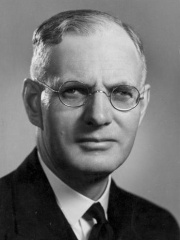
5. John Curtin (1885 - 1945)
With an HPI of 51.34, John Curtin is the 5th most famous Australian Politician. His biography has been translated into 40 different languages.
John Curtin (8 January 1885 – 5 July 1945) was an Australian politician who served as the 14th prime minister of Australia from 1941 until his death in 1945. He held office as the leader of the Australian Labor Party (ALP), having been most notable for leading the country through the majority of World War II, including all but the last few weeks of the war in the Pacific. Curtin's leadership skills and personal character were acclaimed by his political contemporaries and he is frequently ranked as one of Australia's greatest prime ministers and political leaders. Curtin left school at the age of 13 and became involved in the labour movement in Melbourne. He joined the Labor Party at a young age and was also involved with the Victorian Socialist Party. He became state secretary of the Timberworkers' Union in 1911 and federal president in 1914. Curtin was a leader of the "No" campaign during the 1916 referendum on overseas conscription, and was briefly jailed for refusing to attend a compulsory medical examination. He moved to Perth the following year to become the editor of the Westralian Worker, and later was state president of the Australian Journalists' Association. After three unsuccessful attempts, Curtin was elected to the House of Representatives at the 1928 federal election, winning the Division of Fremantle. He is the only prime minister to have represented a constituency in Western Australia. He remained loyal to the Labor government during the party split of 1931. He lost his seat in Labor's landslide defeat at the 1931 election, but won it back in 1934. The following year, Curtin was elected party leader in place of James Scullin, defeating Frank Forde by a single vote. The party gained seats at the 1937 and 1940 elections, with the latter resulting in a hung parliament. The ALP eventually formed a minority government in October 1941, when the Fadden government lost a confidence motion. The Japanese attacks on British Malaya and Pearl Harbour occurred two months after Curtin became prime minister, and Australia entered the war against Japan. Bombing raids on northern Australia soon followed. Curtin led the nation's war effort and made significant decisions about how the war was conducted. He placed Australian forces under the command of the American general Douglas MacArthur, with whom he formed a close relationship, and successfully negotiated the issue of overseas conscription that had split his party during World War I. The ALP won almost two-thirds of the seats in the House of Representatives at the 1943 election, which remains a party record. Curtin died in office in July 1945, after months of ill health attributed to the stresses of the war. Many of his post-war reconstruction plans were implemented by his successor Ben Chifley, who in 1946 led the ALP to consecutive victories for the first time.

6. Kevin Rudd (1957 - )
With an HPI of 51.00, Kevin Rudd is the 6th most famous Australian Politician. His biography has been translated into 80 different languages.
Kevin Michael Rudd (born 21 September 1957) is an Australian diplomat and former politician who served as the 26th prime minister of Australia from 2007 to 2010 and June 2013 to September 2013. He held office as the leader of the Australian Labor Party (ALP). Rudd has been the 23rd and current ambassador of Australia to the United States since 2023. Born in Nambour, Queensland, Rudd graduated from the Australian National University with honours in Chinese studies, and is fluent in Mandarin. Before entering politics, he worked as a diplomat and public servant for the Goss Ministry. Rudd was elected to the Australian House of Representatives at the 1998 federal election, as a member of parliament (MP) for the division of Griffith. He was promoted to the shadow cabinet in 2001 as Shadow Minister for Foreign Affairs. In December 2006, he defeated Kim Beazley in a leadership spill to become the leader of the Labor Party, thus becoming Leader of the Opposition. Rudd led Labor to a landslide victory at the 2007 election, defeating the Howard government. The Rudd government's earliest acts included action on climate change through ratification of the Kyoto Protocol and delivering the first national apology to Australia's Indigenous peoples for the Stolen Generations. The Government also provided economic stimulus packages in response to the financial crisis of 2007–2008, resulting in Australia becoming one of the only developed countries to avoid the late-2000s recession. Other signature policies included establishing the National Broadband Network (NBN), launching the Digital Education Revolution and the Building the Education Revolution, dismantling WorkChoices, and withdrawing Australian troops from the Iraq War. In 2010, Rudd began to face instability within his party, after the Australian Senate rejected his government's proposed Carbon Pollution Reduction Scheme. This prompted deputy prime minister Julia Gillard to challenge him for the leadership of the Labor Party in June of that year. Rather than contest the leadership, Rudd chose to resign, meaning that Gillard replaced him as prime minister. His removal from office began a sequence of four subsequent prime ministers who would all be removed by their own parties before completing their full first term. Rudd remained in the party as a backbencher, and chose to re-contest his seat at the 2010 election, which resulted in a Gillard-led minority government. Within the Gillard government, Rudd was brought back into the Cabinet by Gillard as Minister for Foreign Affairs. He remained in that role until resigning in February 2012, citing Gillard's failure to discipline colleagues who had publicly criticised him. In response, Gillard called a leadership spill, which Rudd lost. Tensions over the leadership nevertheless continued; after a spill in March 2013, which Rudd did not contest, a further ballot was held in June 2013, which Rudd won by 57 votes to 45, becoming prime minister once again. His second term as prime minister lasted less than three months, as Labor was defeated at the 2013 election. Rudd retired from parliament following the election, but has stayed active in politics. In February 2014, he was named Senior Fellow at the John F. Kennedy School of Government at Harvard University, where he leads research on the future of China–United States relations. He was also appointed as a distinguished fellow-in-residence at the Paulson Institute within the University of Chicago in September of that year. Additionally, he is chair of the Independent Commission on Multilateralism, chair of Sanitation and Water for All, and chairman of the board at the International Peace Institute. In January 2021, he was assigned as the eighth president and CEO of the Asia Society. Notably, Rudd has campaigned against media mogul Rupert Murdoch's dominance in Australian political debate, and called for a royal commission into media diversity in the country. He was appointed as Australia's Ambassador to the U.S. by the Albanese government in March 2023. Rudd maintained long periods of popularity in opinion polls during his initial tenure as prime minister for successfully helping Australia through the global financial crisis and for his well renowned apology to the Indigenous community, but he saw a rapid decrease in popularity both in public polling and within his own party after his failure to deliver key pieces of legislation. He was praised for his management of the global financial crisis, willingness to apologise to Indigenous Australians, and diplomatic skills, but was widely criticised for his failure to negotiate a carbon pricing scheme and a tax on non-renewable resources. He is often ranked in the middle-to-lower tier of Australian prime ministers.

7. Malcolm Turnbull (1954 - )
With an HPI of 49.89, Malcolm Turnbull is the 7th most famous Australian Politician. His biography has been translated into 69 different languages.
Malcolm Bligh Turnbull (born 24 October 1954) is an Australian former politician and businessman who served as the 29th prime minister of Australia from 2015 to 2018. He held office as leader of the Liberal Party of Australia. Turnbull graduated from the University of Sydney as a Bachelor of Arts and a Bachelor of Laws, before attending Brasenose College, Oxford as a Rhodes Scholar, earning a Bachelor of Civil Law degree. For more than two decades, he worked as a journalist, lawyer, merchant banker, and venture capitalist. He was Chair of the Australian Republican Movement from 1993 to 2000, and was one of the leaders of the unsuccessful "Yes" campaign in the 1999 republic referendum. He was first elected to the Australian House of Representatives as a member of parliament (MP) for the division of Wentworth in New South Wales at the 2004 election, and was Minister for the Environment and Water in the Howard government from January 2007 until December 2007. After coming second in the 2007 leadership election, Turnbull won the leadership of the Liberal Party in a leadership spill the following year and became Leader of the Opposition. However, his support of the Carbon Pollution Reduction Scheme proposed by the Rudd government in December 2009 led in turn to a leadership challenge by Tony Abbott, who defeated Turnbull by a single vote. Though initially planning to leave politics after this, Turnbull chose to remain and was later appointed Minister for Communications in the Abbott government following the Liberal-National Coalition's victory at the 2013 election. Two years later, citing consistently poor opinion polling, Turnbull resigned from the Cabinet on 14 September 2015 and challenged Abbott, successfully reclaiming the leadership of the Liberal Party by ten votes. He was sworn in as prime minister the following day. The Turnbull government initiated the National Innovation and Science Agenda as its key economic priority, working to promote STEM education, increase venture capital funding for new start-ups, and launch an "ideas boom". Turnbull also pursued "city deals" with local and state governments to improve planning outcomes and encourage investment in major infrastructure projects such as the Western Sydney Airport. In 2016, Turnbull led the Coalition to a narrow victory in a double dissolution election. In his second term, Turnbull initiated and campaigned for the "Yes" side in the same-sex marriage plebiscite, which was ultimately successful. Turnbull also announced Snowy Hydro 2.0, a major expansion of the Snowy Mountains Scheme as a key component in enabling the transition to renewable energy. In late 2017, the government experienced a parliamentary eligibility crisis that saw fifteen parliamentarians forced out of Parliament due to concerns about dual citizenship. To address climate change and reform energy policy, in August 2018 Turnbull proposed the National Energy Guarantee. Although initially agreed to by the Cabinet, the policy was ultimately rejected by the party room. This, combined with poor opinion polling, led to Peter Dutton challenging Turnbull for the Liberal leadership. Although Turnbull defeated Dutton in the party room, a majority of MPs demanded a second spill, which Turnbull did not contest. On 24 August 2018, Scott Morrison defeated Dutton and Julie Bishop in the contest, and replaced Turnbull as prime minister. Turnbull resigned from Parliament, triggering a by-election in his former seat of Wentworth. The Liberal Party lost the by-election to independent candidate Kerryn Phelps, which resulted in the Coalition losing its absolute majority in the House of Representatives. Since retiring from politics, Turnbull has become an advisor to Kasada, an Australian cybersecurity start-up. He has been critical of the direction of the Liberal Party, and has joined with his former opponent Kevin Rudd in criticising the dominance of Rupert Murdoch's News Corp in Australian political debate.

8. Bob Hawke (1929 - 2019)
With an HPI of 49.81, Bob Hawke is the 8th most famous Australian Politician. His biography has been translated into 53 different languages.
Robert James Lee Hawke (9 December 1929 – 16 May 2019) was an Australian politician and trade unionist who served as the 23rd prime minister of Australia from 1983 to 1991. He held office as the leader of the Australian Labor Party (ALP), having previously served as the president of the Australian Council of Trade Unions from 1969 to 1980 and president of the Labor Party national executive from 1973 to 1978. Hawke was born in Border Town, South Australia. He attended the University of Western Australia and went on to study at University College, Oxford as a Rhodes Scholar. In 1956, Hawke joined the Australian Council of Trade Unions (ACTU) as a research officer. Having risen to become responsible for national wage case arbitration, he was elected as president of the ACTU in 1969, where he achieved a high public profile. In 1973, he was appointed as president of the Labor Party. In 1980, Hawke stood down from his roles as ACTU and Labor Party president to announce his intention to enter parliamentary politics, and was subsequently elected to the Australian House of Representatives as a member of parliament (MP) for the division of Wills at the 1980 federal election. Three years later, he was elected unopposed to replace Bill Hayden as leader of the Australian Labor Party, and within five weeks led Labor to a landslide victory at the 1983 election, and was sworn in as prime minister. He led Labor to victory a further three times, with successful outcomes in 1984, 1987 and 1990 elections, making him the most electorally successful prime minister in the history of the Labor Party. The Hawke government implemented a significant number of reforms, including major economic reforms, the establishment of Landcare, the introduction of the universal healthcare scheme Medicare, brokering the Prices and Incomes Accord, creating APEC, floating the Australian dollar, deregulating the financial sector, introducing the Family Assistance Scheme, enacting the Sex Discrimination Act to prevent discrimination in the workplace, declaring "Advance Australia Fair" as the country's national anthem, initiating superannuation pension schemes for all workers, negotiating a ban on mining in Antarctica and overseeing passage of the Australia Act that removed all remaining jurisdiction by the United Kingdom from Australia. In June 1991, Hawke faced a leadership challenge by the Treasurer, Paul Keating, but Hawke managed to retain power; however, Keating mounted a second challenge six months later, and won narrowly, replacing Hawke as prime minister. Hawke subsequently retired from parliament, pursuing both a business career and a number of charitable causes, until his death in 2019, aged 89. Hawke remains his party's longest-serving Prime Minister, and Australia's third-longest-serving prime minister behind Robert Menzies and John Howard. He is also the only prime minister to be born in South Australia and the only one raised and educated in Western Australia. Hawke holds the highest-ever approval rating for an Australian prime minister, reaching 75% approval in 1984. Hawke is frequently ranked within the upper tier of Australian prime ministers by historians.

9. Robert Menzies (1894 - 1978)
With an HPI of 49.20, Robert Menzies is the 9th most famous Australian Politician. His biography has been translated into 41 different languages.
Sir Robert Gordon Menzies (20 December 1894 – 15 May 1978) was an Australian politician and lawyer who served as the 12th prime minister of Australia from 1939 to 1941 and 1949 to 1966. He held office as the leader of the United Australia Party (UAP) in his first term, and subsequently as the inaugural leader of the Liberal Party of Australia, which he was responsible for establishing and defining in policy and political outreach. He is the longest-serving prime minister in Australian history. Menzies studied law at the University of Melbourne and became one of Melbourne's leading lawyers. He was Deputy Premier of Victoria from 1932 to 1934, and then transferred to Federal Parliament, subsequently becoming Attorney-General of Australia and Minister for Industry in the government of Joseph Lyons. In April 1939, following Lyons's death, Menzies was elected leader of the United Australia Party (UAP) and sworn in as Prime Minister. He authorised Australia's entry into World War II in September 1939, and spent four months in England to participate in meetings of Churchill's war cabinet. On his return to Australia in August 1941, Menzies found that he had lost the support of his party and consequently resigned as Prime Minister. He subsequently helped to create the new Liberal Party, and was elected its inaugural leader in August 1945. At the 1949 federal election, Menzies led the Liberal–Country coalition to victory and returned as prime minister. His appeal to the home and family, promoted via reassuring radio talks, matched the national zeitgeist as the economy grew and middle-class values prevailed; the Australian Labor Party's support had also been eroded by Cold War scares. After 1955, his government also received support from the Democratic Labor Party, a breakaway group from the Labor Party. Menzies won seven consecutive elections during his second term, eventually retiring as prime minister in January 1966. Despite the failures of his first administration, his government is remembered for its development of Australia's capital city of Canberra, its expanded post-war immigration scheme, emphasis on higher education, and national security policies, which saw Australia contribute troops to the Korean War, the Malayan Emergency, the Indonesia–Malaysia confrontation, and the Vietnam War.
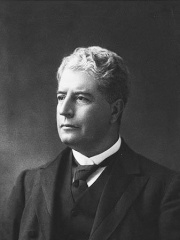
10. Edmund Barton (1849 - 1920)
With an HPI of 49.04, Edmund Barton is the 10th most famous Australian Politician. His biography has been translated into 51 different languages.
Sir Edmund "Toby" Barton (18 January 1849 – 7 January 1920) was an Australian statesman, barrister and jurist who served as the first prime minister of Australia from 1901 to 1903. He held office as the leader of the Protectionist Party, before resigning in 1903 to become a founding member of the High Court of Australia, on which he served until his death. He was highly regarded as one of the leaders and founding fathers of the Federation movement and for his work in drafting and later interpreting the Constitution of Australia and early federal laws. Barton was an early supporter of the federation of the Australian colonies, the goal of which he summarised as "a nation for a continent, and a continent for a nation". After the retirement of Henry Parkes he came to be seen as the leader of the federation movement in New South Wales. He was a delegate to the constitutional conventions, playing a key role in the drafting of a national constitution, and was one of the lead campaigners for federation in the subsequent referendums. In late 1900, despite the initial "Hopetoun Blunder", Barton was commissioned to form a caretaker government as Australia's first prime minister. His term began on 1 January 1901, the date on which federation occurred. At the first federal election in March 1901, Barton and the Protectionists won the most seats, but were well short of a majority. He was able to remain as prime minister by forming an alliance with the fledgling Australian Labor Party (ALP), which held the balance of power. The Barton government established a number of new national institutions, including the Australian Defence Force and the Commonwealth Public Service. It introduced nation-wide women's suffrage, and laid the foundations of the White Australia policy with the Immigration Restriction Act 1901. Barton left politics in 1903 to become one of the three founding members of the High Court, which his government had created. He was succeeded as prime minister by Alfred Deakin. On the court, Barton was able to shape the judicial interpretation of the constitution he had helped write.
Pantheon has 50 people classified as politicians born between 1849 and 2000. Of these 50, 24 (48.00%) of them are still alive today. The most famous living politicians include John Howard, Scott Morrison, and David Hurley. The most famous deceased politicians include Harold Holt, John Curtin, and Bob Hawke. As of April 2022, 10 new politicians have been added to Pantheon including Joan Hartigan, Edith Cowan, and H. V. Evatt.
Living Politicians
Go to all Rankings
John Howard
1939 - Present
HPI: 53.16
Scott Morrison
1968 - Present
HPI: 52.00
David Hurley
1953 - Present
HPI: 51.83
Kevin Rudd
1957 - Present
HPI: 51.00
Malcolm Turnbull
1954 - Present
HPI: 49.89
Dawn Fraser
1937 - Present
HPI: 47.77
William Deane
1931 - Present
HPI: 47.21
Paul Keating
1944 - Present
HPI: 46.54
Quentin Bryce
1942 - Present
HPI: 46.23
Peter Garrett
1953 - Present
HPI: 44.90
Bob Brown
1944 - Present
HPI: 34.72
Julie Bishop
1956 - Present
HPI: 33.96

Deceased Politicians
Go to all Rankings
Harold Holt
1908 - 1967
HPI: 55.46
John Curtin
1885 - 1945
HPI: 51.34
Bob Hawke
1929 - 2019
HPI: 49.81
Robert Menzies
1894 - 1978
HPI: 49.20
Edmund Barton
1849 - 1920
HPI: 49.04
Gough Whitlam
1916 - 2014
HPI: 48.56
Malcolm Fraser
1930 - 2015
HPI: 48.10
Alfred Deakin
1856 - 1919
HPI: 46.53
William McMahon
1908 - 1988
HPI: 46.34
Gerald Patterson
1895 - 1967
HPI: 44.73
Michael Jeffery
1937 - 2020
HPI: 44.05
Stanley Bruce
1883 - 1967
HPI: 43.48

Newly Added Politicians (2022)
Go to all Rankings
Joan Hartigan
1912 - 2000
HPI: 37.24
Edith Cowan
1861 - 1932
HPI: 36.60
H. V. Evatt
1894 - 1965
HPI: 31.59
Gladys Berejiklian
1970 - Present
HPI: 29.93
Marise Payne
1964 - Present
HPI: 29.55
Alexander Downer
1951 - Present
HPI: 27.72
Peter Dutton
1970 - Present
HPI: 24.73
Barnaby Joyce
1967 - Present
HPI: 23.61
Erin Densham
1985 - Present
HPI: 20.12
Tess Coady
2000 - Present
HPI: 8.11

Which Politicians were alive at the same time? This visualization shows the lifespans of the 25 most globally memorable Politicians since 1700.

